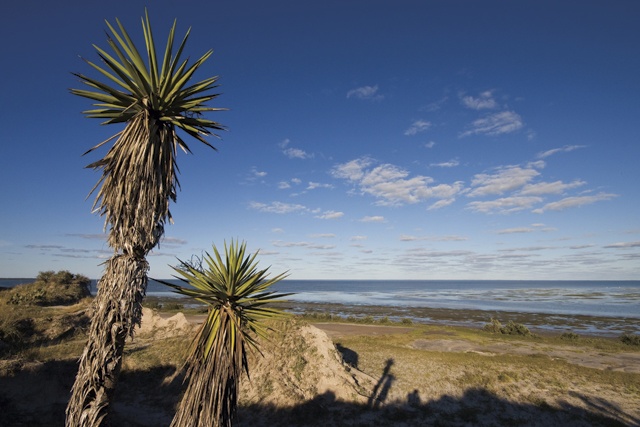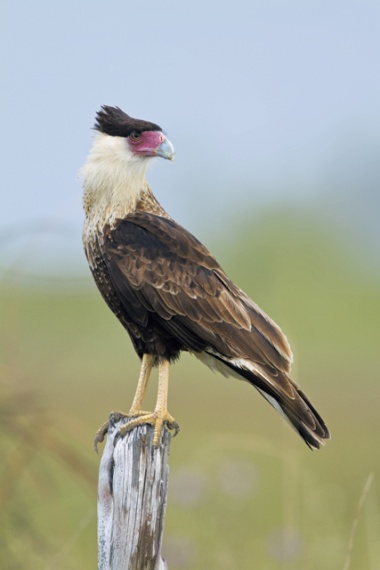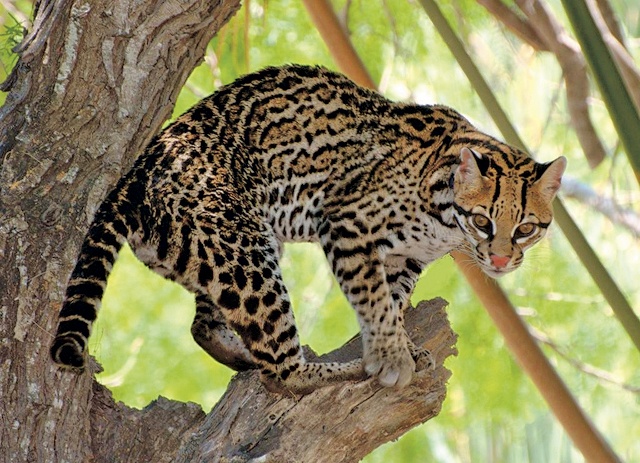About as far south as you can go in Texas along the Gulf of Mexico, and hugging the shoreline of Laguna Madre, lie some of the last undeveloped coastal areas in the United States—thousands of acres of temperate, subtropical, coastal and desert habitat. To the naked eye, Laguna Atascosa National Wildlife Refuge, part of the nearly 180,000-acre South Texas Refuge Complex, is a forbidding landscape of low, tightly enmeshed, thorny brush broken by vast stretches of grassland, shallow ponds and sand flats.
But be still. Listen. Scan the sky, peer through the thicket and be alert for movement. Open your senses to the world of ospreys, ocelots, hawks, roseate spoonbills, coyotes, bobcats, cranes, redhead ducks and alligators.
The opportunity to spend time on foot, on a bicycle or even in a vehicle in the midst of this rare environment may not be everyone’s idea of a getaway. But if you find solace and inspiration in open spaces and long to get lost in the sheer wonder of a falcon taking flight from his perch on a yucca bloom or a bobcat sauntering across the road ahead of you, then come on down
The refuge, about 20 miles east of Harlingen, is home to nine endangered or threatened species, including the ocelot and Aplomado falcon, and 417 recorded bird species—a mix of wildlife found nowhere else.
In addition, the freshwater Laguna Atascosa has been recognized since the late 1800s as a major wintering area for migrating waterfowl, most notably the redhead duck. In 1946, the area became part of the National Wildlife Refuge System founded in 1903 by President Theodore Roosevelt. The lake’s observation deck is the perfect spot for taking photographs of the myriad species of ducks as they deftly land feet-first on the water. Or capture the roseate spoonbill using its long bill like an oar to thrash up some dinner.
Of all the wildlife on the refuge, ocelots are among the rarest and most elusive.
Primarily nocturnal, but occasionally sighted during the day, these wild cats are skittish. The U.S. Fish and Wildlife Service is actively monitoring their population, restoring their required thornscrub habitat and conducting outreach to make the public aware of their plight.
Stroll around the visitor center for a sense of some of the flora and fauna found throughout the refuge. A restful butterfly garden; lusciously colored green jays with their plumage of greens and midnight blue; the striking orange, gold and black Altamira oriole; wispy huisache with its frail yellow blossoms; fragrant Mexican olive trees. Spend some quiet time in observation from the photo blind. If you’re lucky, the resident alligator—resplendent in his coat of luminous green duckweed—will be sunning himself near the trail.
Laguna Atascosa Wildlife Refuge is served by Magic Valley Electric Cooperative.
Laguna Atascosa Tips
Although the refuge is open to the public year-round, the most popular times to visit are during the migration seasons, when millions of waterfowl lay over for food and rest on their way south in the fall and north in the spring.
A variety of programs are offered seasonally, including tram, kayak and birding tours, but visitors may hike, bike or drive on their own at any time.
Some guided tours charge a nominal fee and require reservations. Call ahead to check schedules and availability, Laguna Atascosa Visitors Center, (956) 748-3607. Find a complete listing of visitor activities and tours here.
The annual Ocelot Conservation Festival is the best time to see a live ocelot. To learn more about this beautiful cat, become a Facebook fan of Viva the Ocelot.
Restaurant tip: Eat at Joe’s. Joe’s Oyster Bar in Port Isabel features fresh seafood, prepared delectably and served with a smile.
——————–
Carol Moczygemba, executive editor
Visiting Laguna Atascosa
Laguna Atascosa National Wildlife Refuge is part of the South Texas Refuge Complex, which includes the South Padre Island habitat for the endangered Kemp’s ridley turtle, the Roma Bluffs World Birding Center and the Bahia Grande Wetlands Restoration Project.
This extraordinary 97,000-acre ecosystem in the Lower Rio Grande Valley provides protection for nine federally listed endangered or threatened species, including the largest population of ocelots in the U.S.
Managed by the U.S. Fish and Wildlife Department, Laguna Atascosa is a living laboratory for human intervention in preserving and restoring the coastal brush lands, tidal flats, prairies, wetlands, clay formations, and barrier island beaches and dunes that create this wilderness sanctuary.
Enjoying the refuge
Laguna Atascosa is open to the public year-round from sunrise to sunset. The visitor center is open from 8 a.m. to 4 p.m. daily except on major holidays. It is advisable to call in advance as hours are subject to change. Phone for more information or reservations on guided tours: (956) 748-3607.
To get the most out of your trip, take advantage of guided tours as well as opportunities to explore on your own. The best time to view the most birds and wildlife is during the cooler months.
With the $3 entry fee per car, you may take advantage of guided walking tours—including native plant walks, forest and lake bird walks and gator tours—led by a refuge staff member.
There are two driving tours and multiple hiking trails. Bicycles are permitted on tour roads and some service roads. Kayak tours are seasonal (June-September).
Bayside Tram Tour
A 2 1/2-hour ride in an open-air tram along a 16-mile loop that skirts Laguna Madre and runs through brush lands and wetlands. Adults $4, seniors $3.50, children $1; January-September.
Find complete visitor and tour information here.
Volunteering at Laguna Atascosa National Wildlife Refuge
The refuge depends on volunteers and interns to assist with a variety of programs and duties.
Opportunities
Depending on interests and qualifications, opportunities may include:
Conducting bird, butterfly, plant or other interpretive programs;
Welcoming and providing information to visitors;
Improving or maintaining trails and public-use facilities;
Developing environmental education materials and programs;
Assisting with landscaping, small engine repair, electrical work, heavy equipment operation, plumbing, carpentry and other such projects;
Assisting with computer or office work;
Assisting with special events, biological surveys or other ongoing projects.
Resident Volunteers
RV pads with full hookups are available to volunteers who commit to three months of 24-hour work weeks.
Student Interns
Student interns receive housing and a living allowance stipend.
For more information, contact the refuge at (956) 748-3607 or email Stacy Sanchez.



